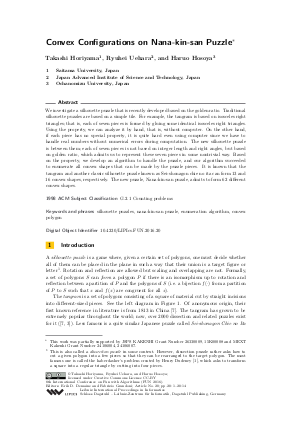Convex Configurations on Nana-kin-san Puzzle
Authors Takashi Horiyama, Ryuhei Uehara, Haruo Hosoya
-
Part of:
Volume:
8th International Conference on Fun with Algorithms (FUN 2016)
Part of: Series: Leibniz International Proceedings in Informatics (LIPIcs)
Part of: Conference: International Conference on Fun with Algorithms (FUN) - License:
 Creative Commons Attribution 3.0 Unported license
Creative Commons Attribution 3.0 Unported license
- Publication Date: 2016-06-02
File

PDF
LIPIcs.FUN.2016.20.pdf
- Filesize: 0.8 MB
- 14 pages
Document Identifiers
Subject Classification
Keywords
- silhouette puzzles
- nana-kin-san puzzle
- enumeration algorithm
- convex polygon
Metrics
- Access Statistics
-
Total Accesses (updated on a weekly basis)
0PDF Downloads0Metadata Views
Abstract
We investigate a silhouette puzzle that is recently developed based on the golden ratio. Traditional silhouette puzzles are based on a simple tile. For example, the tangram is based on isosceles right triangles; that is, each of seven pieces is formed by gluing some identical isosceles right triangles. Using the property, we can analyze it by hand, that is, without computer. On the other hand, if each piece has no special property, it is quite hard even using computer since we have to handle real numbers without numerical errors during computation. The new silhouette puzzle is between them; each of seven pieces is not based on integer length and right angles, but based on golden ratio, which admits us to represent these seven pieces in some nontrivial way. Based on the property, we develop an algorithm to handle the puzzle, and our algorithm succeeded to enumerate all convex shapes that can be made by the puzzle pieces. It is known that the tangram and another classic silhouette puzzle known as Sei-shonagon chie no ita can form 13 and 16 convex shapes, respectively. The new puzzle, Nana-kin-san puzzle, admits to form 62 different convex shapes.
Cite As Get BibTex
Takashi Horiyama, Ryuhei Uehara, and Haruo Hosoya. Convex Configurations on Nana-kin-san Puzzle. In 8th International Conference on Fun with Algorithms (FUN 2016). Leibniz International Proceedings in Informatics (LIPIcs), Volume 49, pp. 20:1-20:14, Schloss Dagstuhl – Leibniz-Zentrum für Informatik (2016)
https://doi.org/10.4230/LIPIcs.FUN.2016.20
BibTex
@InProceedings{horiyama_et_al:LIPIcs.FUN.2016.20,
author = {Horiyama, Takashi and Uehara, Ryuhei and Hosoya, Haruo},
title = {{Convex Configurations on Nana-kin-san Puzzle}},
booktitle = {8th International Conference on Fun with Algorithms (FUN 2016)},
pages = {20:1--20:14},
series = {Leibniz International Proceedings in Informatics (LIPIcs)},
ISBN = {978-3-95977-005-7},
ISSN = {1868-8969},
year = {2016},
volume = {49},
editor = {Demaine, Erik D. and Grandoni, Fabrizio},
publisher = {Schloss Dagstuhl -- Leibniz-Zentrum f{\"u}r Informatik},
address = {Dagstuhl, Germany},
URL = {https://drops.dagstuhl.de/entities/document/10.4230/LIPIcs.FUN.2016.20},
URN = {urn:nbn:de:0030-drops-58730},
doi = {10.4230/LIPIcs.FUN.2016.20},
annote = {Keywords: silhouette puzzles, nana-kin-san puzzle, enumeration algorithm, convex polygon}
}
Author Details
References
-
Henry Ernest Dudeney. The Canterbury Puzzles. Dover, 1958.

-
Eli Fox-Epstein, Kazuho Katsumata, and Ryuhei Uehara. The Convex Configurations of "Sei Shonagon Chie no Ita," Tangram, and Other Silhouette Puzzles with Seven Pieces. IEICE Trans. on Inf. and Sys., accepted, 2016.

-
Martin Gardner. Origami, Eleusis, and the Soma Cube. The New Martin Gardner Mathmatical Library. Cambridge, 2008.

-
Jason S. Ku, Erik D. Demaine, Matias Korman, Joseph Mitchell, Yota Otachi, Marcel Roeloffzen, Ryuhei Uehara, Yushi Uno, and Andre van Renssen. Symmetric Assembly Puzzles are Hard, Beyond a Few Pieces. In The 18th Japan Conference on Discrete and Computational Geometry and Graphs (JCDCGG 2015), 2015.

-
Joseph Malkevitch. Problem 707, solution by M. Goldberg. Math. Mag., 42:158, 1969.

-
Joseph Malkevitch. Tiling Convex Polygons with Equilateral Triangles and Squares. Annals of the New York Academy of Science, 440:299-303, 1985.

-
Jerry Slocum and Jacob Botermans. The Tangram Book: The Story of the Chinese Puzzle with Over 2000 Puzzles to Solve. Sterling Publishing, 2004.

-
M. Uematsu. Personal communication. 2015.

-
Fu Traing Wang and Chuan-Chih Hsiung. A Theorem on the Tangram. The American Mathematical Monthly, 49(9):596-599, 1942.

